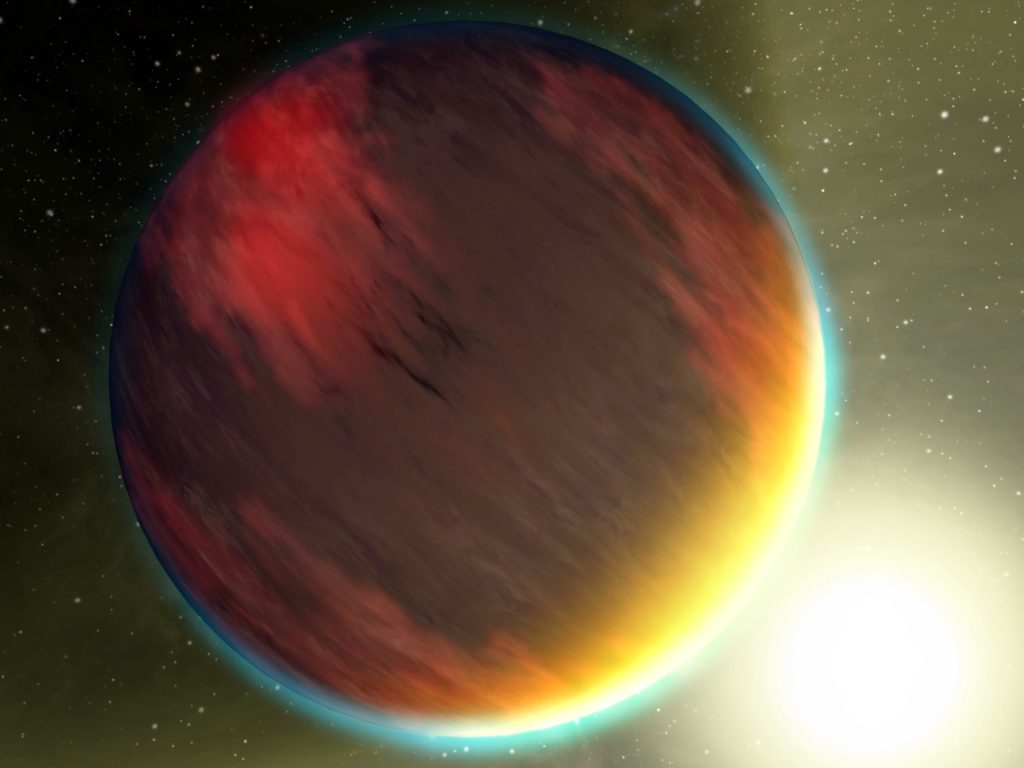
Exoplanets
Hi, I’m Marley, the astronomer here at the Space Centre. Our theme for the month of August is Exoplanets, planets outside of our Solar System. In March, the number of confirmed exoplanets climbed past 5000, and there are nearly 9000 waiting to be confirmed as exoplanets. To commemorate this milestone, I thought we could take a look at the history, and the future, of exoplanet research.
The Firsts and Spitzer
The ‘first’ exoplanet discovery is a point of debate among exoplanet hunters. In 1992, the very first clearly identified planetary bodies discovered outside our Solar System were found to be orbiting a pulsar – not a star like our Sun. Two planets were found orbiting this stellar remnant, and another was confirmed in 1994. The first exoplanet to be found orbiting a main-sequence star (a star like our Sun) was later announced in 1995 by a Swiss team. It is this discovery that is widely acknowledged as the first true exoplanet orbiting a ‘normal’ star. Scientists argue that since the extreme environment around a pulsar makes the planets orbiting them drastically different from the planets that orbit the still living stars we are more familiar with. Either way, the search for exoplanets has been going on for nearly 30 years, and the discovery of exoplanets has exploded over the years. **
Jump to August 24th, 2003, the day that the Spitzer Space Telescope launches. Its original mission goals did not include exoplanets, but changes made by astronomers and engineers made Spitzer an important part of exoplanet research. Being an infrared telescope, Spitzer saw things in a different way from the Hubble Space Telescope. It was able to see the cooler, smaller objects that don’t emit visible light but do emit infrared. These objects include small stars, giant molecular clouds, and exoplanets. Spitzer made many amazing discoveries, including helping find and reveal the exoplanets in the TRAPPIST-1 system, and categorize them as rocky. It even observed temperature variations on the exoplanet HD 80606b. Spitzer was able to observe atmospheric changes to HD 80606b as it approached and left its star. Not only did it make discoveries on its own, but Spitzer was a team player, helping to refine and confirm the findings of other spacecraft, like the Kepler Space Telescope.
Kepler and TESS
In March 2009, the Kepler Space Telescope launches. It is one of the first space telescopes whose mission is focused on finding exoplanets. During its primary mission, Kepler discovers over 1000 exoplanets, the first rocky one being discovered in 2011. The primary mission, to continuously monitor more than 150,000 stars in search of exoplanets, ends in May of 2013 due to a hardware malfunction. Following this failure, the Kepler team regrouped and developed a new mission that would enable scientific observations. This phase, named K2, became fully operational in May 2014. Every three months, the area of the sky that K2 looked at changed, but that did not stop the discoveries. 3246 of the confirmed exoplanets were discovered by Kepler/K2, with another just over 3000 waiting to be confirmed. Observations continued until Kepler runs out of fuel, and the mission comes to an end in November 2018. By this point, the Transiting Exoplanet Survey Satellite (TESS) had launched. The step after Kepler, TESS surveys 200,000 of the brightest stars near the Sun and searches for exoplanets. TESS will eventually survey the entire sky, an area 400 times larger than what Kepler monitored. The stars TESS is observing are 30 to 100 times brighter than the stars observed by Kepler, and this makes them far easier to follow up with ground-based and other space-based telescopes. While currently sitting at 227 confirmed exoplanets, TESS still has nearly 6,000 waiting to be confirmed. It is still surveying, with a 5th year of observations planned.
The Future
The exoplanet journey does not end with TESS. The James Webb Space Telescope, launched at the end of 2021, is about to begin science operations. Part of its scientific mission is to explore other worlds. JWST will use spectroscopy to learn more about the atmospheres of exoplanets. It will even be able to directly image some exoplanets. JWST is equipped with a coronagraph that will block out the light of the star, leaving the exoplanets visible. The images won’t be in great detail, more like a spot than anything else, but these direct images will still provide valuable science. You can read more about JWST in this blog post, here.
The future of exoplanet research won’t be ending with JWST. Two other space telescopes will hopefully launch before the year 2030. The Nancy Grace Roman Telescope (NGRST), set to launch in 2027, will study many things, one of them being exoplanets. NGST will be able to observe exoplanets using three different methods. One of its missions will be to monitor 200 million stars towards the centre of our galaxy, searching for exoplanets. The other space telescope is the Atmospheric Remote sensing Infrared Exoplanet Large-survey, or just ARIEL, being developed by the ESA. It will observe about 1,000 exoplanets, studying their composition, formation, and evolution.
We have come a long way from our first exoplanet discoveries. In about 30 years, we have gone from the firsts to launching a telescope capable of determining if exoplanets could have atmospheres similar to Earth’s. Who knows where we will be discovered in the next 30 years? Until then, try some of the activities below.
** As if the question of ‘first’ isn’t confusing enough, in 1988, a Canadian team announced the discovery of an exoplanet, Gamma Cephei A b. As the team continued to study the exoplanet and its star, they began to doubt their original finding that an exoplanet was orbiting the star and they withdrew their discovery. As it turned out the team not only developed a new technique to track the motion of stars but they did discover an exoplanet. Gamma Cephei A was confirmed as an exoplanet in 2002.
Astronomer’s playlist
Time
Activity
30 min
What’s in a name?
There are lots of terms used when describing exoplanets and exoplanet candidates. Read this short article to discover what it takes for a candidate to be confirmed as an exoplanet.
And then discover more about how exoplanets get their names.
If you’re curious about the guidelines astronomers use to name objects visit the International Astronomical Union’s naming guidelines.
Ask yourself: what would you want to name an exoplanet if you discovered one?
30 min
Could there be life?
It’s more about just spotting an exoplanet—understanding how its atmosphere works is the next big focus for astronomers. Understanding a planet’s atmosphere will help to determine if the exoplanet could support life. Read this article about exoplanet atmospheres.
The ESA’s ARIEL telescope currently under development is looking for help in how it will develop models to help understand exoplanet atmospheres. Have a look at the Ariel Data Challenge to see another approach to involving people in exoplanet exploration.
Ask yourself: What else would you want to learn about an exoplanet?
90+ min
Travel to an exoplanet
Pack your bags and start exploring exoplanets. Visit NASA’s Exoplanet Travel Bureau to get started. Then go on an exoplanet scavenger hunt. If you need a little break, have fun with this old school video game.
Ask yourself: If you could travel to an exoplanet, which one would you like to visit and why?
120+ min
Contribute to the discovery of exoplanets
There are a lot so citizen science projects that you can participate in. Check out the following projects and maybe you can contribute to the discovery of new exoplanets.
Ask yourself: How else could you contribute to the science of exoplanets?
Planet Hunters Tess: https://www.zooniverse.org/projects/nora-dot-eisner/planet-hunters-tess
Planet Hunters NGTS: https://www.zooniverse.org/projects/mschwamb/planet-hunters-ngts
Exoplanet watch: https://exoplanets.nasa.gov/exoplanet-watch/about-exoplanet-watch/overview/

